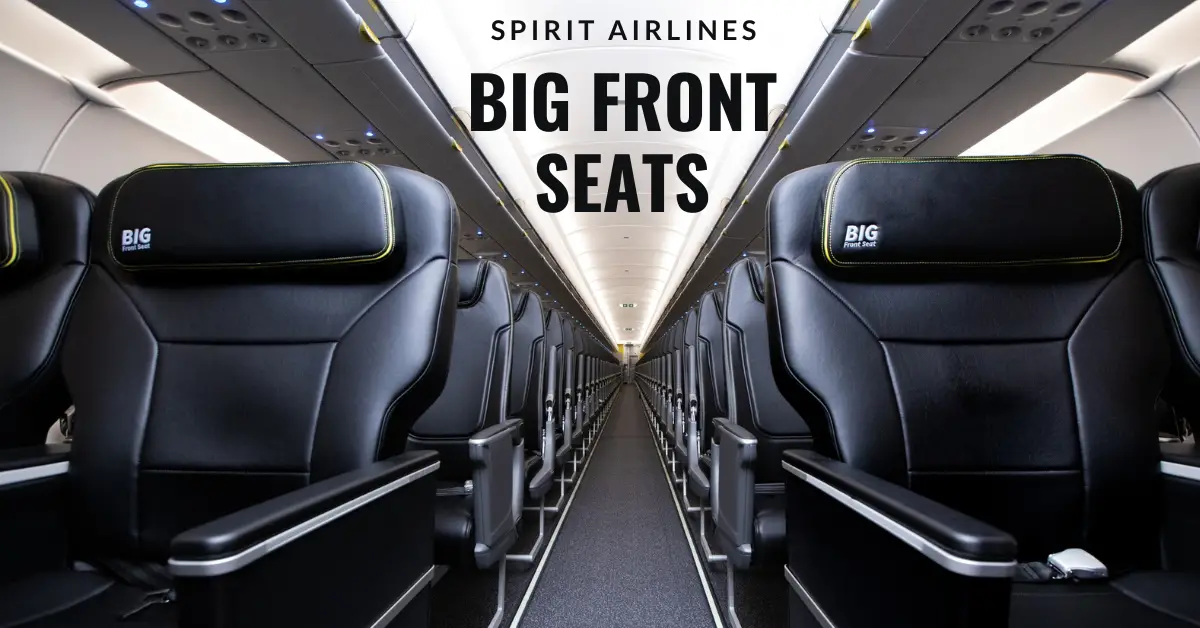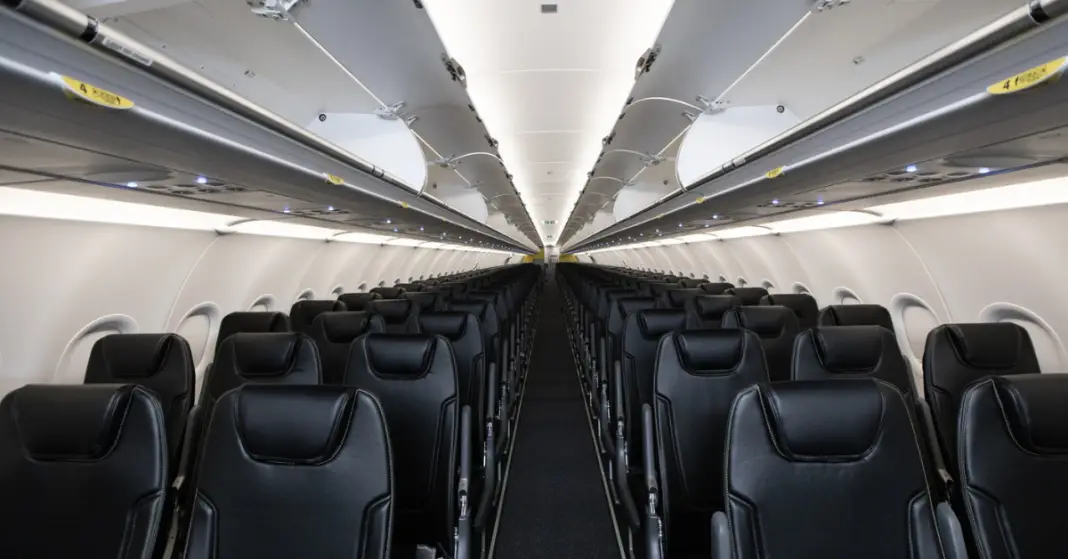When embarking on a journey with Spirit Airlines, passengers encounter a distinctive flight experience that diverges from the traditional classifications of airline seating. This blog embarks on a detailed exploration of Spirit Airlines’ avant-garde approach to passenger comfort and cost efficiency. As we delve into the world of travel where luxury is often synonymous with exclusivity, Spirit Airlines challenges the status quo by eschewing a conventional First Class section.
Instead, they offer an innovative alternative with their all-economy cabin layout, complemented by the ‘Big Front Seat’—a nod to premium comfort without the full suite of high-end amenities. Through the course of this article, we will dissect the particulars of Spirit Airlines‘ seating, uncovering the strategic underpinnings of their market position and the balance of cost versus comfort they present to today’s budget-conscious flier.
Table of Contents
Does Spirit offer 1st class?
Although not classified as “first class” in the conventional sense, Spirit Airlines provides an elevated seating experience known as the Big Front Seat. This option includes additional legroom, increased width, early access to overhead bin space, a reclining seat, and power outlets as its key amenities.
What is the best seat on Spirit Airlines?
While the term “best seat” can be subjective, there are certain factors that objectively contribute to a more comfortable and enjoyable flight experience. On Spirit Airlines, extra legroom often reigns supreme when it comes to passenger preferences.
Does Spirit Airlines have business class?
No, Spirit Airlines doesn’t have a conventional business class. Nevertheless, they provide a premium seating choice known as the Big Front Seat, often regarded as their equivalent to business class.
Does Spirit Airlines have different classes?
No, Spirit Airlines doesn’t employ the traditional multiple-class system seen in other airlines. Instead, they utilize a single cabin configuration, commonly known as a coach. However, within the coach class, they provide various seat options and add-ons, enabling passengers to personalize their flying experience.
What seats are first class in Spirit?
Spirit Airlines doesn’t provide a conventional first-class cabin. Nevertheless, they do present a premium seating alternative called the Big Front Seat, which serves as the closest equivalent to first class in their offerings.
Spirit Airlines’ Seating Overview
Navigating the skies with a budget in mind doesn’t have to condemn passengers to a one-size-fits-all approach. Enter Spirit Airlines – where the savvy traveler can customize their flight experience right down to the seating. This is no-frills flying with a twist; you only pay for what you need.
When booking a flight with Spirit, the choice is yours: snag that ultra-affordable bare fare and settle into a standard seat, or upgrade to a Big Front Seat® for legroom that’ll make any journey a breeze. Standard seats on Spirit are what you’d expect from a budget carrier; they’re functional, with pre-requisite comfort for a short trip, coming with a pitch of 28 inches.

However, those looking to pair their economy ticket with a premium seating experience will be wowed by the Big Front Seat® – it’s an entrepreneur’s dream without the first-class fuss. Think ample space, 36 inches of pitch, 18.5 inches of width, and the comfort of a deluxe leather seat without the exorbitant price tag.
What’s clear is that Spirit Airlines presents options for every type of traveler. From the minimalist jet setters to those who work as they fly, the airline’s innovative approach to seating ensures that even the most budget-conscious can fly comfortably and arrive refreshed. After all, it’s about the journey as much as the destination. Spirit understands that, reinventing the economics of air travel to meet the diverse needs of today’s explorers. With their customizable seating arrangements, Spirit proves that the sky’s the limit – in more ways than one.
Understanding the ‘Big Front Seat’
Embarking on air travel often presents a conundrum for the passenger prioritizing both value and comfort. Yet, the introduction of the available ‘Big Front Seat®’ by Spirit Airlines proved to be the ingenious solution satisfying both ends of the spectrum.
The ‘Big Front Seat®’ strategically targets those flyers who, while historically price-sensitive, do not compromise on the traveling experience. The seats do not merely redefine physical space; they transform the flyer’s journey into a realm of comfort traditionally reserved for first-class tickets on other carriers, demonstrating that luxury does not always have to carry an exorbitant price tag.
Furthermore, the ‘Big Front Seat®’ serves a multifaceted purpose, recognizing that a flight is not merely a means to an end but a phase of productivity for the business traveler.
Investing in this upgrade allows the traveler to create a temporary office in the sky, complete with the elbow room necessary to open a laptop, review documents, or brainstorm the next big innovation without the typical constraints of personal space found in standard economy seating. It’s a prime example of how an airline can personalize the flying experience catering to the evolving needs of modern passengers.
Ultimately, the ‘Big Front Seat®‘ by Spirit Airlines exemplifies a triumph of market responsiveness, allowing individuals and entrepreneurs alike to tailor their journey by both financial prudence and the desire for an enhanced travel experience. This option stands as a testament to Spirit’s ingenuity and foresight in accommodating the breadth and diversity of today’s traveler ambitions, thereby, redefining value-focused air travel with a keen eye toward qualitative choice.
Market Position and Strategy
Diving deeper into the strategic underpinnings of Spirit Airlines’ seating model, one finds a keen alignment with the elasticity of market demand. A significant proportion of today’s air travelers are not just searching for affordability; they are on a quest for specificity in services rendered.
A pivotal demographic serviced by Spirit’s model are savers who occasionally yearn for luxury without the extravagance of full-service airlines. By offering differentiated seating, Spirit taps into the nuanced gradations within the budget-conscious sector, allowing passengers to make preferential choices without compromising the airline’s low-cost promises.
The model goes beyond addressing consumer budgets; it encapsulates efficiency in customer experience. The ‘Big Front Seat®’ proposition acknowledges that even within the realm of economy travel, there exists a segment that values comfort, particularly on longer flights. For travelers who wish to arrive refreshed, and capable of diving straight into work or leisure, this option is a game-changer.
With the rise in freelance and remote work, Spirit recognizes the need for business travelers to make the most of their time in transit. Intellectual workers, digital nomads, and vacationers can both indulge in the spaciousness of a ‘Big Front Seat®’ and also discern the alignment with their fiscal sensibility.
In essence, Spirit Airlines has not merely changed the seating—it has redefined the perception of value. By directly addressing the heterogeneity of the contemporary traveler’s preferences, Spirit has established itself as a thought leader in budget air travel, disruptively tweaking the industry’s traditional one-size-fits-all approach. Crucially, this vision for seating flexibility signifies one thing: in the dynamic arena of air travel, innovation is the true north, and Spirit is adeptly navigating these currents.
Cost vs. Comfort: A Comparative Analysis
Stepping outside the usual boundaries of budget travel, Spirit Airlines offers a game-changer in-flight comfort without the traditional first-class price tag. It’s a truth universally acknowledged that first-class amenities come with a hefty fare—a price point that once seemed non-negotiable for premium space and comfort. However, clarity comes in comparing the tangible benefits of a first-class ticket with the practical innovation offered by Spirit’s seating choices.
While first class affords a certain level of exclusivity, with amenities like multi-course meals and a dedicated attendant, it’s imperative to evaluate the actual necessity of these luxuries against their cost. Here’s where Spirit’s Big Front Seat® plays its ace; for those who seek comfort over caviar, the Big Front Seat® provides an elevated experience without frivolous extras.
Let’s think of it as a luxurious blank canvas—it delivers the foundations of comfort for the sophisticated traveler to customize. Why pay for extravagance when what’s required is foundational comfort? A 36-inch pitch and an 18.5-inch seat width proffer ample sanctuary for relaxation or productivity, aligning nearly with the traditional first-class standards.
Pivoting the conversation towards practicality, it becomes apparent that Spirit’s seating has redefined expectations within the realm of value air travel. This strategy acknowledges the evolution of consumer behavior—travelers are now apt to opt for an agile approach, seeking out custom experiences that meet their specific needs without the weight of unnecessary opulence.
These offerings reflect not only an adaptation to consumer trends but also project a visionary model within the industry. Spirit recognizes that modern travelers are leaning into a more conscious selection of services, selecting substance over the superfluous. As such, Spirit is carving out airspace where value and satisfaction intersect, diverging from the conventions associated with traditional first-class, yet preserving the essence of airborne elegance and functionality.
As we come full circle in our exploration of Spirit Airlines’ seating dynamics, it becomes apparent that the carrier has carved out a unique niche in the aviation market. Their cost-effective yet comfortable ‘Big Front Seat’ offering embodies a revolutionary approach to travel that caters to the practical needs of the modern traveler.
This look at Spirit Airlines helps us understand where it fits in the airline industry. It also makes us think more broadly about what’s important in air travel: getting good value for your money compared to having luxurious features. For people who want a mix of affordable prices and some comfort, Spirit Airlines is a great example. It shows how airlines can meet what customers want without breaking their main promise of giving a cheap flying experience.





